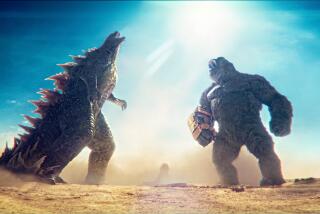Box Office Monster’s Real Appeal
- Share via
Dinosaurs have invaded the San Fernando Valley.
Again.
Or should I say, “Take 2”? For picking up where “Jurassic Park” left off, “The Lost World” has demonstrated once more that dinosaurs, some 70 million years after their extinction, still rule the earth--or at any rate, make for very good box office business. Forget Tom Cruise, Harrison Ford or Brad Pitt: You want a sure draw? Hire T. rex.
The success of Steven Spielberg’s latest is good news for the Valley, which stands to benefit enormously from a booming entertainment industry. Filling the void left by the collapse of aerospace--that other lost world--entertainment, along with the high-tech firms that design the special effects audiences find so enthralling, promises to rescue the Valley’s economy from its own brush with extinction.
But have you ever wondered why we are entertained by the spectacle of dinosaur-bites-man? Why, that is, do we pay good money to see the simulated digestion of our fellow human beings?
*
These are the sorts of questions asked by those of us who take popular culture seriously enough to spend our time analyzing it. In asking such questions it is not our intent to deny the primary purpose of the products of popular culture, which, of course, is to entertain. Rather, when we ask why we are entertained, our presumption is that popular behavior is a kind of sign, or symptom, of deeper human realities, and that by interpreting such signs we can learn a good deal about ourselves.
Our response to “The Lost World,” I think, is one such sign. And the first thing that appears when we come to analyze that sign is that there is nothing new about it.
Long before the current dinosaur craze, in fact long before we even had any knowledge of dinosaurs, large, scaly monsters were haunting our imagination. Just think of Jonah’s “whale” (big fish, actually), and all of his imaginative progeny, which include everything from “Moby Dick” to “Jaws” to the Loch Ness monster. Think too of all those medieval dragons and of that modern dragon the Japanese called Godzilla.
The late Canadian scholar Northrop Frye gave us a name for such recurring figures in our storytelling imagination. Adapting the work of the psychologist Carl Jung, he called them “archetypes.” Archetypes, in Frye’s sense, comprise those related products of our imagination that repeat themselves across time and space. Sea monsters, sharks, dinosaurs, dragons: These all form a single archetype. Other archetypes include the quest hero and the dragon slayer (indeed, the modern “action” hero is archetypally related to the dragon slayers of yore: Beowulf meets Arnold Schwarzenegger--or Sigourney Weaver).
Archetypes help explain the popularity of dinosaurs, for as Frye has noted, the more “archetypal” a story is, the more popular it is likely to be. Audiences are unconsciously drawn to the anciently familiar.
There is something else that is anciently familiar about dinosaurs that may also help explain their popularity. As a recent book by culture critic Barbara Ehrenreich argues, human beings have harbored throughout history an unconscious “memory” of the prehistoric days when they were the prey of animals that were larger and better “armed” than themselves. Ehrenreich’s thesis in “Blood Rites” is that war is the product of that memory, a violent ritual that assuages our unconscious fears. The unconscious logic runs like this: The better armed we are, the less likely we are to get eaten.
*
Watching our fears of being eaten alive dramatically represented on the silver screen may also help assuage them. Here we can take a tip from something the Greek philosopher Aristotle had to say about the effect of dramatic tragedy. By witnessing the fall of the tragic hero, Aristotle argued, we work our own terror out of our systems. He called this working out “catharsis.” In this sense, then, dinosaur films are cathartic: By witnessing the digestion of someone not unlike ourselves, we work through our own terror of being digested.
That’s something to think about as you, like practically everyone else in America these days, line up at the ticket counter to watch celluloid monsters make hors d’oeuvres of hapless humans.
More to Read
The biggest entertainment stories
Get our big stories about Hollywood, film, television, music, arts, culture and more right in your inbox as soon as they publish.
You may occasionally receive promotional content from the Los Angeles Times.










